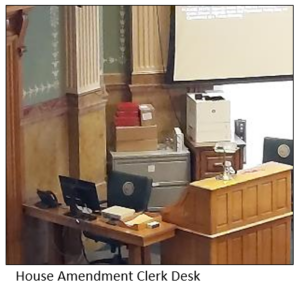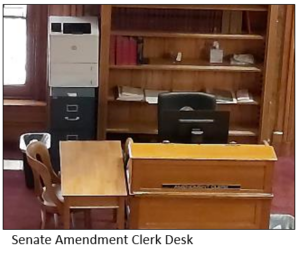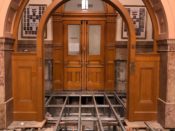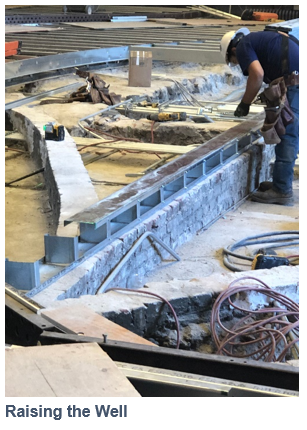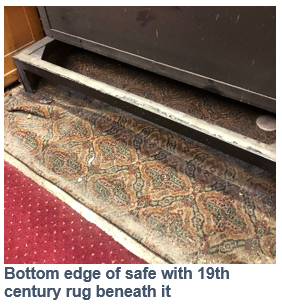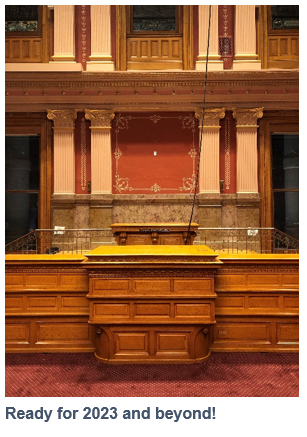by Sarah Meisch
The Twenty-fourth Session of the Colorado General Assembly convened on January 3, 1923, with its members poised to pass cornerstone water and conservation legislation. This session would change how the Colorado River is allocated, address wildlife preservation, establish Armistice Day, and enhance care for children and the blind in Colorado.
The Colorado River Compact
One of the most important pieces of legislation passed in 1923 was the approval of the Colorado River Compact, which had been signed in Santa Fe, New Mexico, on November 24, 1922. Governor-appointed commissioners from Arizona, California, Colorado, Nevada, New Mexico, Utah, and Wyoming attended a conference in early November 1922 to determine how the river water should be allocated between the Colorado River Basin states. Many of the Basin states were newly concerned with securing their state’s water supply due to California’s robust population growth and a U.S. Supreme Court ruling from June 1922, which had declared the law of prior appropriation; this law expressed that, “whoever used the water first had first right of use in times of shortage … regardless of state lines.” The states had an urgent need to come to an equitable agreement to prevent California from requesting water other Basin states believed they had rights to instead.
The Colorado River Compact was the first time in American history when more than three states came together to distribute the waters of a stream or river, and it became the bedrock for the “Law of the River” — the series of laws and contracts that regulate the use of the Colorado 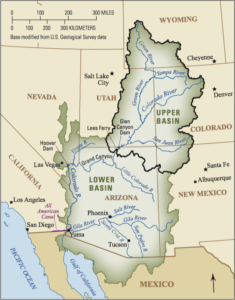 River. The agreement effectively ended navigation and commerce on the river and prioritized the value of the water for domestic and agricultural needs.
River. The agreement effectively ended navigation and commerce on the river and prioritized the value of the water for domestic and agricultural needs.
The Compact was not binding until each of the Basin states approved it within their state legislatures and the U.S. Congress ratified it. The General Assembly in 1923 determined that the act was “necessary for the immediate preservation of public peace, health, and safety”, and the act was approved on April 2, 1923. Only six of the seven states needed to ratify the compact, and the Colorado River Compact officially took effect in 1929. Arizona would not ratify the agreement until 1944 due to the state’s concerns with the way the Compact allocated water to the Upper and Lower Basins rather than to each of the states directly.
The Compact also raised the future question of Mexican ownership over areas of the Colorado River. Water allocations to Mexico were addressed in the Mexican Water Treaty of 1944.
Colorado Game and Fish
The General Assembly established several state game refuges in 1923 to regulate and prohibit the killing of certain protected game in Colorado. Violators of state game refuge laws would be guilty of a misdemeanor and punished by a fine of up to $100 and/or imprisonment for up to 60 days in the county jail. The restrictions seem to have been successful for at least one protected animal – the Abert’s Squirrel, which currently ranks as an animal of “least concern” for extinction.
animal of “least concern” for extinction.
The 1923 legislation outlined particular limitations on game hunting, including a declaration that there would be no open season on partridges. A maximum of eight geese could be killed or found in a person’s possession in a single day, and only one deer and one elk could be killed by an individual in the entirety of the hunting season. The laws imposed by the 1923 General Assembly were an extension of Colorado’s wildlife protection legislation, which was initially passed to preserve game and fish in Colorado Territory in 1870.
Armistice Day
In 1923, the General Assembly changed “Liberty Day”, which was established in 1919, to “Armistice Day.” Legislation established Armistice Day on November 11 each year to commemorate the success of the Allies “against Germany and the survival of liberty and democracy at home and abroad.” Congress passed a resolution in 1926 for annual observance of the holiday, but by that time 27 state legislatures had already turned the day into a legal holiday. In 1938, Armistice Day became a national holiday, and in 1954 Armistice Day became “Veterans Day”.
In 1968, a controversial new federal law changed the date of Veterans Day from the eleventh day of November to the fourth Monday in October to provide federal employees with a consistent three-day weekend. The first year of observance for the new date was 1971, but two states refused to switch the date, and veterans groups ardently opposed the change. In 1974, several newspaper editorials called for Congress to restore November 11 as the date of observance, and a few months later, 46 of the 50 states ignored the federal celebration in October, opting to switch back to the November 11 date or refusing to move the holiday altogether. In 1975, President Ford amended the Uniform Monday Holiday Act and changed Veterans Day back to November 11. Veterans Day has fallen on November 11 since 1978.
Care for Neglected Children and the Blind
Several acts were approved in 1923 to assist with the care of children, mothers, and the blind. The State Home for Dependent and Neglected Children received needed repairs, support, and maintenance that year, and an appropriation was made to construct a nursery cottage and remodel other institutional buildings. The Sheppard-Towner Act was enacted to promote the proper hygiene and welfare of mothers and infants.
The General Assembly also allocated money to the Industrial Workshop for the Blind to support its operating and maintenance costs. Readers for the blind were paid for any services rendered to blind residents of Colorado who graduated from the Colorado School for Deaf and Blind and were employed within Colorado higher education. This program allowed the blind greater accessibility and opportunity across the state.
Conclusion
The 1923 General Assembly’s concern with conservation of our natural resources portended future discussions that continue to echo through the halls of the Colorado State Capitol and the U.S. Capitol today. The Colorado River Compact, the conservation of state refuges and wildlife, and the care of the disadvantaged were key legislative themes of the 1923 General Assembly, but the public’s interest in these issues remains just as keen in 2023.
Citations
- Abert’s Squirrel. June 26, 2021. National Park Service. https://www.nps.gov/band/learn/nature/aberts-squirrel.htm.
- “Arizona Department of Water Resources.” Colorado River Management | Arizona Department of Water Resources. Accessed December 21, 2022. https://new.azwater.gov/crm.
- Assessment), Francesca Cassola (Global Mammal. “The IUCN Red List of Threatened Species.” IUCN Red List of Threatened Species, January 11, 2017. https://www.iucnredlist.org/species/42461/22245623.
- “Celebrating America’s Freedoms: The Origins of Veterans Day.” Washington, D.C.: U.S. Department of Veterans Affairs, n.d.
- Colorado River Basin Map. USGS: Science for a Changing World. USGS, November 3, 2016. https://www.usgs.gov/media/images/colorado-river-basin-map.
- “Colorado River Compact.” Water Education Foundation. Accessed December 21, 2022. https://www.watereducation.org/aquapedia-background/colorado-river-compact#:~:text=The%20Colorado%20River%20Compact%20of,river%20for%20years%20to%20come.
- History.com Editors. “Veterans Day 2022.” History.com. A&E Television Networks, October 14, 2009. https://www.history.com/topics/holidays/history-of-veterans-day.
- History.com Editors. “Veterans Day Facts.” History.com. A&E Television Networks, October 14, 2009. https://www.history.com/topics/holidays/veterans-day-facts.
- “How Americans Fought to Restore Veterans Day to November 11.” National Constitution Center – constitutioncenter.org. Accessed December 21, 2022. https://constitutioncenter.org/blog/how-americans-fought-to-restore-veterans-day-to-november.
- Session Laws of Colorado: 1923. Denver, CO: The Bradford-Robinson Printing Co., 1923.
- Zimmer, Amy. “Time Machine Tuesday: History of Colorado’s Game, Fish and Parks Agencies.” Colorado Virtual Library, March 4, 2020. https://www.coloradovirtuallibrary.org/resource-sharing/state-pubs-blog/time-machine-tuesday-history-of-colorados-game-fish-and-parks-agencies/.


